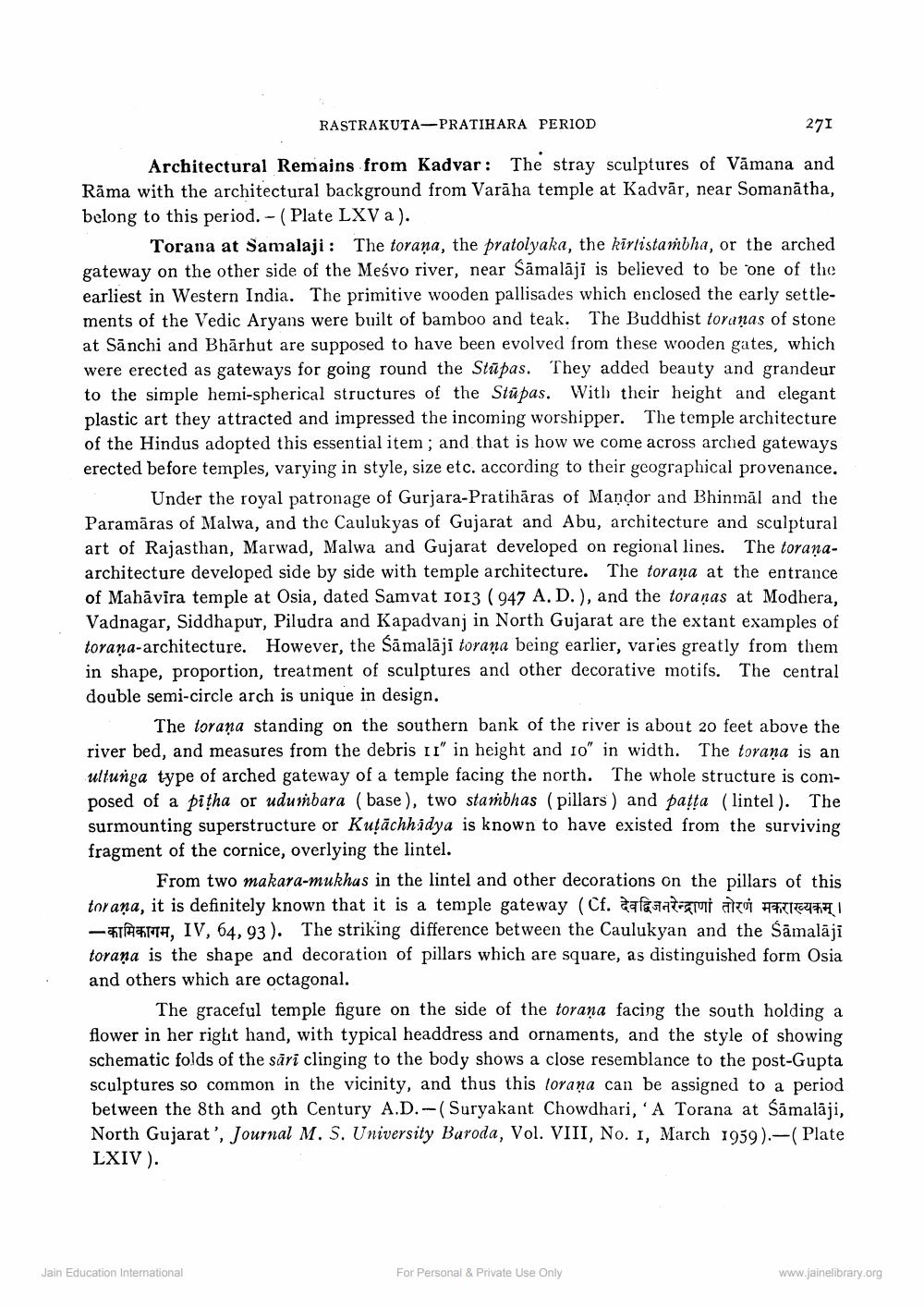________________
RASTRAKUTA-PRATIHARA PERIOD
271 Architectural Remains from Kadvar: The stray sculptures of Vămana and Rāma with the architectural background from Varāha temple at Kadvār, near Somanātha, belong to this period. - (Plate LXV a).
Torana at Samalaji: The torana, the pratolyaka, the kirlistambha, or the arched gateway on the other side of the Meśvo river, near Sämalāji is believed to be one of the earliest in Western India. The primitive wooden pallisades which enclosed the early settlements of the Vedic Aryans were built of bamboo and teak. The Buddhist toranas of stone at Sānchi and Bhārhut are supposed to have been evolved from these wooden gates, which were erected as gateways for going round the Stūpas. They added beauty and grandeur to the simple hemi-spherical structures of the Stūpas. With their height and elegant plastic art they attracted and impressed the incoming worshipper. The temple architecture of the Hindus adopted this essential item; and that is how we come across arched gateways erected before temples, varying in style, size etc. according to their geographical provenance.
Under the royal patronage of Gurjara-Pratihāras of Mandor and Bhinmāl and the Paramāras of Malwa, and the Caulukyas of Gujarat and Abu, architecture and sculptural art of Rajasthan, Marwad, Malwa and Gujarat developed on regional lines. The toranaarchitecture developed side by side with temple architecture. The toraņa at the entrance of Mahāvira temple at Osia, dated Samvat 1013 ( 947 A.D.), and the toraņas at Modhera, Vadnagar, Siddhapur, Piludra and Kapadvanj in North Gujarat are the extant examples of torana-architecture. However, the Sāmalāji torana being earlier, varies greatly from them in shape, proportion, treatment of sculptures and other decorative motifs. The central double semi-circle arch is unique in design.
The torana standing on the southern bank of the river is about 20 feet above the river bed, and measures from the debris 11" in height and 10" in width. The torana is an ultunga type of arched gateway of a temple facing the north. The whole structure is composed of a pitha or udumbara (base), two stambhas (pillars) and patta (lintel). The surmounting superstructure or Kuțāchhidya is known to have existed from the surviving fragment of the cornice, overlying the lintel.
From two makara-mukhus in the lintel and other decorations on the pillars of this toraņa, it is definitely known that it is a temple gateway (Cf. dalasatami AITOT APTITUTI -F ATTA, IV, 64,93). The striking difference between the Caulukyan and the Sāmalāji torana is the shape and decoration of pillars which are square, as distinguished form Osia and others which are octagonal.
The graceful temple figure on the side of the torana facing the south holding a flower in her right hand, with typical headdress and ornaments, and the style of showing schematic folds of the sări clinging to the body shows a close resemblance to the post-Gupta sculptures so common in the vicinity, and thus this lorana can be assigned to a period between the 8th and gth Century A.D.-(Suryakant Chowdhari, 'A Torana at Samalāji, North Gujarat', Journal M. S. University Baroda, Vol. VIII, No. 1, March 1959).-(Plate LXIV).
Jain Education Intemational
For Personal & Private Use Only
www.jainelibrary.org




